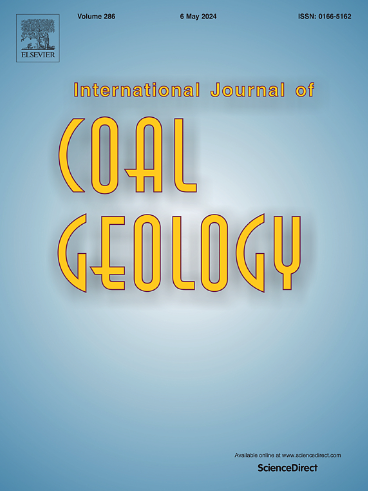Mineralogy and elemental geochemistry of Pennsylvanian high-sulfur coals in the Huanghebei Coalfield, Shandong, Northern China: Implications for the enrichment and controlling factors of U
IF 5.7
2区 工程技术
Q2 ENERGY & FUELS
引用次数: 0
Abstract
Uranium enrichment in coal is of great significance for understanding metallogenic processes and assessing resource potential. Numerous studies have investigated the geochemical behavior and modes of occurrence of U in super-high-organic‑sulfur coals from Southern China. However, the Huanghebei Coalfield in Shandong, a major high‑sulfur coal-bearing region in North China, yet remains largely unidentified. This study investigates the U enrichment and controlling factors of the Pennsylvanian No.11 coal from Huanghebei Coalfield, Shandong, Northern China. Uranium is enriched in the No. 11 coal (up to 89.3 μg/g), where U, Mo, and V are exclusively concentrated in the topmost coal bench underlying the limestone roof. The enrichment of critical elements, including U, Mo, and V, is attributed to infiltration of marine water from the overlying strata during the early diagenetic stage. Uranium in the coal shows both organic and inorganic associations. Notably, a small portion of U occurs in uraninite, which is more easily reduced and precipitated under anoxic conditions. The relationships of Al2O3 vs. TiO2, Al2O3/TiO₂-Nb/Yb and the REY distribution patterns indicate that the sediment-source rocks of the No. 11 coal were the North Qinling Orogenic Belt. The predominant minerals identified in the No. 11 coal are NH₄-illite, calcite, quartz, pyrite, bassanite and kaolinite, with minor amounts of dolomite and siderite. The modes of occurrence of NH4-illite, kaolinite, calcite, pyrite, and quartz, as well as fluorapatite, indicate that the No. 11 coal was likely influenced by multi-stage injection of hydrothermal fluids. Authigenic NH4-illite is relatively high abundant, probably formed by the interaction of kaolinite with nitrogen released from organic matter during metamorphism induced by igneous intrusion. The δ13CVPDB and δ18OVPDB values of epigenetic carbonates in the coals indicate that the carbon and oxygen in the carbonates are primarily derived from hydrothermal fluid activities. The No. 11 coal has potential for resource development and utilization as raw material for U and deserves further attention.
山东黄河北煤田宾夕法尼亚系高硫煤的矿物学及元素地球化学特征:对U - 2富集及控制因素的启示
煤中铀的富集对认识成矿过程和评价资源潜力具有重要意义。大量研究对中国南方超高有机硫煤中铀的地球化学行为和赋存模式进行了研究。然而,作为中国北方主要的高硫含煤地区,山东黄河北煤田在很大程度上仍未被发现。研究了山东黄河北煤田宾夕法尼亚系11号煤铀富集特征及控制因素。铀富集于11号煤中(最高可达89.3 μg/g),其中U、Mo、V均集中在石灰岩顶板下的最上层煤阶中。U、Mo、V等关键元素的富集与上覆地层海水在早期成岩阶段的渗透有关。煤中铀既有有机结合又有无机结合。值得注意的是,小部分铀存在于铀矿中,在缺氧条件下更容易还原和沉淀。Al2O3与TiO2、Al2O3/TiO 2 -Nb/Yb的关系及REY分布模式表明,11号煤的沉积源岩为北秦岭造山带。在11号煤中发现的主要矿物为硫酸铵伊利石、方解石、石英、黄铁矿、玄武岩和高岭石,少量白云石和菱铁矿。nh4 -伊利石、高岭石、方解石、黄铁矿、石英和氟磷灰石的赋存方式表明11号煤可能受到多期热液注入的影响。自生nh4 -伊利石相对丰富,可能是在火成岩侵入变质过程中高岭石与有机质释放的氮相互作用形成的。煤中表观成因碳酸盐的δ13CVPDB和δ18OVPDB值表明,碳酸盐中的碳和氧主要来源于热液活动。11号煤作为铀原料具有资源开发利用潜力,值得进一步重视。
本文章由计算机程序翻译,如有差异,请以英文原文为准。
求助全文
约1分钟内获得全文
求助全文
来源期刊

International Journal of Coal Geology
工程技术-地球科学综合
CiteScore
11.00
自引率
14.30%
发文量
145
审稿时长
38 days
期刊介绍:
The International Journal of Coal Geology deals with fundamental and applied aspects of the geology and petrology of coal, oil/gas source rocks and shale gas resources. The journal aims to advance the exploration, exploitation and utilization of these resources, and to stimulate environmental awareness as well as advancement of engineering for effective resource management.
 求助内容:
求助内容: 应助结果提醒方式:
应助结果提醒方式:


